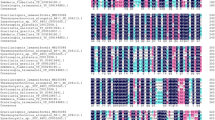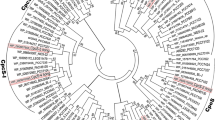Abstract
The phycobilisomes attached to the outer side of the thylakoid membrane absorb and transmit light energy in cyanobacteria and red algae. They consist of phycobiliproteins and linker polypeptides. LCM involved in the attachment of the phycobilisomes to the membrane is called core–membrane linker polypeptide. This study aimed to clone the apcE gene encoding the core–membrane linker polypeptide ApcE from Arthrospira platensis FACHB314. Then, the apcE gene was expressed with phycocyanobilin synthesis–related elements in Escherichia coli. The fluorescence emission spectra showed that purified ApcE was fluorescing (λmax = 670 nm), indicating that ApcE could bind with phycocyanobilin in low yield in an autocatalytic reaction. The Cys201, Cys419, Cys616, and Cys644 of the polypeptide were mutated to investigate the binding sites of ApcE with phycocyanobilin. The fluorescence peak of mutant strain E.coli HPApcE201 almost did not exist, implying that Cys201was the binding site of ApcE. The ApcE and allophycocyanin (APC) or phycocyanins (PC) were co-expressed in E. coli separately to investigate the role of ApcE in the fluorescence activity of phycobiliproteins. The mass spectrometry results showed that high–molecular weight protein polymers of ApcE and APC or of ApcE and PC might exist. The fluorescence emission spectra showed that the characteristic fluorescence peak of APC and PC was higher and the wavelength range of fluorescence peak was larger with ApcE expression.




GenBank were as follows: Synechococcus sp. PCC 7002 (AAC14723.2), Anacystis nidulans (CAA37514.1), Synechococcus elongatus (BAA09857.1), Gracilariopsis tenuifrons (AXF36098.1), Griffithsia pacifica (ATG31120.1), Anabaena sp. PCC 7120 (AAC97589.1), Synechocystis sp. PCC 6714 (AAA69685.1), and Arthrospira sp. SRM16 (SMN35251.1)






Similar content being viewed by others
Data availability
The datasets used and analyzed during the current study are available from the corresponding author on reasonable request.
References
Arteni AA, Ajlani G, Boekema EJ (2009) Structural organisation of phycobilisomes from Synechocystis sp. Strain PCC6803 and their interaction with the membrane. BBA Bioenerg 1787:272–279
Betz M, Rüegsegger U, Esteban AM, Sidler WA, Zuber H (1993) Reconstitution of the core complex (αβ)APC3L8.9 of the phycobilisome from Mastigocladus laminosus using the L8.9C linker polypeptide overexpressed in Escherichia coli. Biol Chem Hoppe-Seyler 374:435–443
Bhat VB, Madyastha KM (2000) C-Phycocyanin: A potent peroxyl radical scavenger in vivo and in vitro. Biochem Bioph Res Commun 275:20–25
Biasini M, Bienert S, Waterhouse A, Arnold K, Studer G, Schmidt T, Kiefer F, Gallo Cassarino T, Bertoni M, Bordoli L, Schwede T (2014) Swiss-model: modelling protein tertiary and quaternary structure using evolutionary information. Nucleic Acids Res 42:W252–W258
Biswas A, Vasquez YM, Dragomani TM, Kronfel ML, Williams SR, Alvey RM, Schluchter WM (2010) Biosynthesis of cyanobacterial phycobiliproteins in Escherichia coli:chromophorylation efficiency and specificity of all bilin lyases from Synechococcus sp. strain PCC 7002. Appl Environ Microbiol 76:2729–2739
Capuano V, Braux AS, Marsac N, Houmard J (1991) The “anchor polypeptide” of cyanobacterial phycobilisomes: molecular characterization of the Synechococcus sp. PCC 6301 apcE gene. J Biol Chem 266:7239–7247
Capuano V, Thomas JC, Tandeau de Marsac N, Houmard J (1993) An in vivo approach to define the role of the LCM, the key polypeptide of cyanobacterial phycobilisomes. J Biol Chem 268:8277–8283
Elanskaya IV, Zlenko DV, Lukashev EP, Suzina NE, Kononova IA, Stadnichuk IN (2018) Phycobilisomes from the mutant cyanobacterium Synechocystis sp. PCC6803 missing chromophore domain of ApcE. BBA-Bioenergetics 1859:280–291
Gindt YM, Zhou JH, Bryant DA, Sauer K (1992) Core mutations of Synechococcus sp. PCC 7002 phycobilisomes: A spectroscopic study. J Photochem Photobiol B 15:1–2
Glazer AN (1984) Phycobilisome a macromolecular complex optimized for light energy transfer. BBA Rev Bioenerget 768:29–51
Glazer AN (1994) Phycobiliprotein—a family of valuable, widely used fluorophores. J Appl Phycol 6:105–112
Grossman AR, Schaefer MR, Chiang GG, Collier JL (1993) The phycobilisome, a light-harvesting complex responsive to environmental conditions. Microbiol Rev 57:725–749
Guo YL, Zang XN, Cao XX, Zhang F, Sun DG, Shang MH, Zhaxi YZ, Li R, Yangzong Z, Wei XH, Zhang XC (2020) Cloning and expression of allophycocyanin gene from Gracilariopsis lemaneiformis and studying the binding sites of phycocyanobilin on its α and β subunits. J Appl Phycol 32:2657–2671
Kumar S, Stecher G, Li M, Knyaz C, Tamura K (2018) Mega X: molecular evolutionary genetics analysis across computing platforms. Mol Biol Evol 35:1547–1549
Lai XJ, Gu YH, Tao X, Zhang YZ, Wang HY (2014) Cloning and characterization of uridine diphosphate glucose dehydrogenase gene from Ipomoea batatas. Russ J Plant Physl 61:298–308
Liu LN, Chen XL, Zhang YZ, Zhou BC (2005) Characterization, structure and function of linker polypeptides in phycobilisomes of cyanobacteria and red algae: an overview. BBA - Bioenergetics 1708:133–142
Lundell DJ, Williams RC, Glazer AN (1981) Molecular architecture of a light-harvesting antenna. In vitro assembly of the rod substructures of Synechococcus 6301 phycobilisomes . J Biol Chem 256:3580
Ma JF, You X, Sun S, Wang XX, Qin S, Sui SF (2020) Structural basis of energy transfer in Porphyridium purpureum phycobilisome. Nature 579:146–151
Madeira F, Park YM, Lee J, Buso N, Gur T, Madhusoodanan N, Basutkar P, Tivey ARN, Potter SC, Finn RD, Lopez R (2019) The EMBLl-EBI search and sequence analysis tools APIs in 2019. Nucleic Acids Res 47(W1):W636–W641
Maccoll R (1998) Cyanobacterial phycobilisomes. J Struct Biol 124:311–334
Nyman ES, Hynninen PH (2004) Research advances in the use of tetrapyrrolic photosensitizers for photodynamic therapy. J Photochem Photobiol B 73:1–28
Shih CM, Cheng SN, Wong CS, Kuo YL, Chou TC (2009) Antiinflammatory and antihyperalgesic activity of C-phycocyanin. Anesth Anal 108:1303–1310
Sidler WA (1994) Phycobilisome and phycobiliprotein structures. In: Bryant DA (ed) The Molecular Biology of Cyanobacteria. Kluwer, Dordrecht, pp 139–216
Sun DG, **ao DF, Zang XN, Wu F, ** YM, Cao XX, Guo YL, Liu Z, Wang HT, Zhang XC (2019a) Cloning of the pcyA gene from Arthrospira platensis FACHB314 and its function on expression of a fluorescent phycocyanin in heterologous hosts. J Appl Phycol 31:3665–3675
Sun DG, Zang XN, Guo YL, **ao DF, Cao XX, Liu Z, Zhang F, ** YM, Shi JW, Wang ZD, Li R, Zhaxi YZ (2019b) Cloning of pcB and pcA gene from Gracilariopsis lemaneiformis and expression of a fluorescent phycocyanin in heterologous host. Genes 10:322
Tang K, Ding WL, Höppner A, Zhao C, Zhang L, Hontani Y, Kennis JTM, Gärtner W, Scheer H, Zhou M, Zhao KH (2015) The terminal phycobilisome emitter, LCM: A light-harvesting pigment with a phytochrome chromophore. PNAS 112:15880–15885
Tooley AJ, Cai YA, Glazer AN (2001) Biosynthesis of a fluorescent cyanobacterial C-phycocyanin holo-α subunit in a heterologous host. PNAS 98:10560–10565
Wheeler D, Bhagwat M (2007) BLAST QuickStart: example-driven web-based BLAST tutorial. In: Bergman NH (ed) Methods in Molecular Biology. Springer, Dordrecht, pp 149–176
Zhang WJ, Guan XY, Yang Y, Ge BS, Chen HX, Li FC, Qin S (2009) Biosynthesis of fluorescent allophycocyanin alpha-subunits by autocatalysis in Escherichia coli. Biotechnol Appl Biochem 52:135–140
Zhang R, Feng XT, Wu F, Ding Y, Zang XN, Zhang XC, Yuan DY, Zhao BR (2014) Molecular cloning and expression analysis of a new bilin lyase: the cpcT gene encoding a bilin lyase responsible for attachment of phycocyanobilin to Cys-153 on the β-subunit of phycocyanin in Arthrospira platensis FACHB314. Gene 544:191–197
Zhang J, Ma JF, Liu DS, Qin S, Sun S, Zhao JD, Sui SF (2017) Structure of phycobilisome from the red alga Griffithsia pacifica. Nature 551:57–63
Zlenko DV, Elanskaya IV, Lukashev EP, Bolychevtseva YV, Suzina NE, Pojidaeva ES, Kononova IA, Loktyushkin AV, Stadnichuk IN (2018) Role of the PB-loop in ApcE and phycobilisome core function in cyanobacterium Synechocystis sp. PCC 6803. BBA- Bioenergetics 1860:155–166
Acknowledgements
This work was supported by the National Natural Science Foundation of China (Grant No. 31872555).
Author information
Authors and Affiliations
Corresponding author
Ethics declarations
Conflict of interest
The authors have no conflicts of interest.
Additional information
Publisher's Note
Springer Nature remains neutral with regard to jurisdictional claims in published maps and institutional affiliations.
Rights and permissions
About this article
Cite this article
Bi, Y., Shang, M., Xu, X. et al. Cloning of apcE gene from Arthrospira platensis FACHB314 and its function in heterologous expression. J Appl Phycol 34, 2477–2487 (2022). https://doi.org/10.1007/s10811-022-02793-0
Received:
Revised:
Accepted:
Published:
Issue Date:
DOI: https://doi.org/10.1007/s10811-022-02793-0




